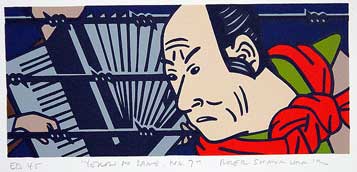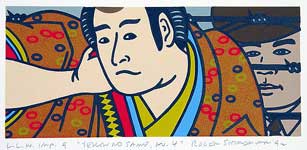A Penetrating Look Into America’s Past
Roger Shimomura to lecture at CSUMB Sept. 16
Throughout his childhood, Roger
Shimomura's questions to his family about their years in a U.S government
internment camp were met with silence.
It's easy to forget now – after
the federal government's apology and reparations to Japanese-Americans –
but for four decades the internment of 120,000 Americans of Japanese descent
during World War II was the great injustice no one would discuss – not even the
victims.
''Whenever I tried, it was
squelched,'' recalls Shimomura, a distinguished professor of art at the
University of Kansas. ''It was such a humiliating, shameful experience that
talking about it would resurrect it – so you didn't,'' Shimomura told the San
Jose Mercury News in an interview several years ago.
Shimomura was in college before
he could finally add some facts to his childhood memories of what his family
quietly called ''the camp experience.'' Now he has filled that void of his
youth with three decades worth of art. Much of his work takes as its
starting point the diaries of his immigrant grandmother, Toku Shimomura, who
recorded her life in America for 56 years.
The artist's exploration of the
internment experience will be on display at the Monterey Museum of Art, where
“Geography of Memory: Works on Paper by Roger Shimomura'' will open Sept.18.
The exhibit is being held in
collaboration with the Department of Visual and Public Art at California State
University, Monterey Bay. Dr. Amalia Mesa-Bains, director of VPA, is the show’s
curator. The artist will appear at CSUMB for a public lecture on Sept. 16.
A Seattle native, Shimomura is
well known for his clean-lined, boldly colored paintings that mix the styles of
comic books and classical Japanese prints. Mr. Shimomura's stock in trade is
his stinging commentary on issues of cross-cultural identity. He
juxtaposes popular American images such as Mickey Mouse, Alice in Wonderland,
Donald Duck, Kentucky Fried Chicken and Superman, intermingling with geisha,
samurai warriors and Kabuki-masked men. Images of traditional Japanese
woodblock prints or Ukiyo-e intertwined with images of an Andy Warhol-like
Marilyn Monroe are common in his art.
The 12 pieces in his series “Yellow No Same” will be
displayed in Monterey. The pieces view life inside
and outside the barbed wire of Minidoka, the camp in Idaho where he and his
family were interned. Each image is divided across the center by a line of
barbed wire.
Outside the wire, he places
classical Japanese figures, inside, Japanese Americans, peering out. One plays
music; another is graduating from school. In one, Mickey Mouse waves from
behind the barbed wire – a comment on isolation and confinement and the
government's decision to put thousands of U.S. citizens behind bars. The series
title refers to the notion implicit in Executive Order 9066 – the World War II
decree that interned Americans of Japanese ancestry on the grounds of “national
security” – that white Americans couldn’t tell the “good Japs” from the bad.
Also on display in Monterey will
be the 10-lithograph series, “Memories of Childhood,” which depict his earliest memories of life in the camp.
The Geography of Memory series – a
show each fall for four years – highlights the ethnic and cultural richness of
the Central Coast through the works of contemporary artists. The project got
under way last year with an exhibit of the works of Chinese artist Hung Liu.
The idea for the series came about several years ago when
the museum asked VPA to help support a program that would provide opportunities
for people to see contemporary art coming from diverse sources.
“Geography of Memory is another
way of looking at cultural landscape, a way of talking about places people
lived and their relationship to the area,” says Dr. Mesa-Bains. Each exhibit
will have an historical component. For the Shimomura show, photographs
documenting the wartime internment of Japanese-Americans from Monterey County
will be displayed.
Directions to the university and a map are available on the university’s
website, csumb.edu.
Anyone desiring disability
accommodations is asked to call 582-4330 one week in advance.
WHAT: Public lecture by Roger Shimomura
WHEN: Thursday, Sept. 16, 2004
WHERE: University Center, CSUMB
TIME: 6:30 p.m. lecture (a reception for the artist will
start at 6)
COST: Free, but $1.50 parking fee must be paid
INFORMATION: 582-4330
Download High-Resolution Images: |
Click on each of the thumbnail images below to download a high-resolution jpeg file: |
|
|
|
|


